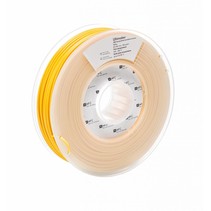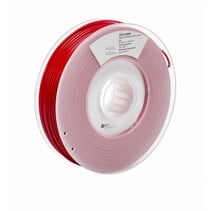UltiMaker ABS
- Marktleider in 3D Printing
- Hoogwaardige service en support
- Fysieke showrooms
How to print with Ultimaker ABS
ABS (acrylonitrile butadiene styrene) is a frequently used 3D printing material. It has good mechanical properties and can be used for a wide range of applications. Ultimaker ABS shows exceptionally low warping and consistent layer bonding, making it more reliable and easier to print with than other regular ABS filaments. This guide will explain all you need to know to print with Ultimaker ABS filament.
Note: The information provided here applies to Ultimaker ABS. Similar quality cannot be guaranteed with third-party filaments.
Compatibility
Ultimaker ABS can be printed on Ultimaker 3D printers that have a heated build plate, although it will print most reliably on the Ultimaker S5, Ultimaker S3, Ultimaker 3, and Ultimaker 2+ (Connect) because of the possibility of enclosing the printer. You should print ABS with the AA print cores on the Ultimaker S5, Ultimaker S3 and Ultimaker 3.
| Printer | Compatible print cores / nozzles |
| Ultimaker S5 (Pro Bundle) | AA 0.25, AA 0.4, AA 0.8 |
| Ultimaker S3 | AA 0.25, AA 0.4, AA 0.8 |
| Ultimaker 3 (Extended) | AA 0.25, AA 0.4, AA 0.8 |
| Ultimaker 2+ Connect | 0.25, 0.4, 0.6, 0.8 |
| Ultimaker 2+ (Extended) | 0.25, 0.4, 0.6, 0.8 |
| Ultimaker 2 (Extended) | 0.4 |
| Ultimaker Original + | 0.4 |
Note: Ultimaker ABS is not supported on the Ultimaker 2 Go and Ultimaker Original because they lack a heated build plate
Ultimaker ABS has optimised settings for the Ultimaker Pro Bundle, Air Manager and Material Station. This ensures a good end of filament and end of print experience in the Material Station and an optimal build environment with the Air Manager. Please make sure to use the latest version of Ultimaker Cura and ensure the firmware has the latest update.
On the Ultimaker S5 and Ultimaker 3, Breakaway can be used as a support material for ABS, and dual-color ABS prints can be made. In the overview below you can see the complete compatibility for Ultimaker ABS.
1 Dual combinations with TPU 95A may result in stringing and blobs on the surface of the print
2 Only possible for small prints. Larger prints may show warping of the build material
Recommended settings and configuration
Note: Always use the latest version of Ultimaker Cura and make sure that your 3D printer is updated with the latest firmware version to include the correct material profile for Ultimaker ABS.
Temperatures
For Ultimaker ABS a slightly higher nozzle temperature is used: between 225 and 260 °C. The exact temperature depends on the selected nozzle size and profile; small nozzles and thin layers use lower temperatures, while bigger nozzles require a higher temperature.
The build plate temperature for Ultimaker ABS is between 80 or 90 °C – depending on the selected printer and nozzle size.
Note: The correct temperatures are automatically used based on the printer, nozzle size, and profile you select in Ultimaker Cura.
Adhesion
Ultimaker ABS has been optimized to minimize warping, which means that the material usually adheres well to the build plate. However, we strongly advise applying a thin layer of glue to the glass plate for optimal adhesion and glass plate protection.
Caution: For Ultimaker ABS we recommend the use of UHU stick to prevent excessive adhesion and avoid the risk of damage on the build plate or printed part.
All default profiles for Ultimaker ABS in Ultimaker Cura use a brim as build plate adhesion type. A brim is made of a few extra printed lines around the 3D print on the initial layer to ensure better adhesion and to avoid warping.
For more tips on how to improve the build plate adhesion, we recommend that you take a look at our build plate adhesion guide.
After printing, it’s common practice to wait for your part to cool down before removing it. But for ABS, it’s often easier to remove the 3D print if the build plate is still slightly warm (at approximately 40 °C).
Print environment
Although Ultimaker ABS prints reliably, the material is prone to delamination when printing large or thin-walled objects. Therefore, it prints best on a printer that is enclosed on all sides – such as the Ultimaker S3 and Ultimaker S5. On the Ultimaker 3 and Ultimaker 2+, it is highly recommended to use the front enclosure included in the Advanced 3D Printing Kit for this material. The front enclosure will help avoid cracks in your 3D prints and will provide a controlled print environment for more consistent and reliable results.
Health and safety
Ultimaker ABS is safe to print when using the recommended temperature settings listed above. To ensure a comfortable and healthy working environment, we recommend 3D printing in a well-ventilated area.













